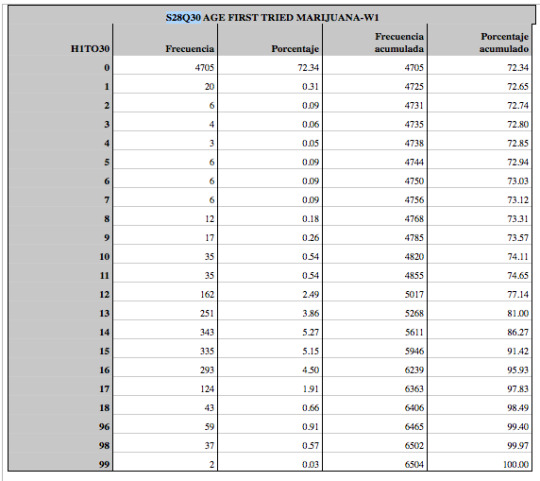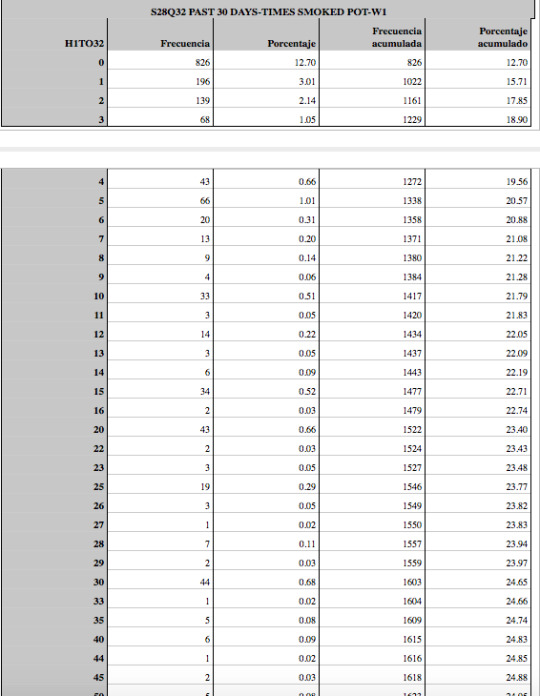Don't wanna be here? Send us removal request.
Text
First analysis about psychoactive use in adolescents

The National Study of Adolescents health is survey to conducted with adolescents between 7 and 12 years old enrolled in the school (n= 6.504). 72% of adolescents have not smoked marijuana in the life and near to 20% started to smoke marijuana between 12 and 16 years old. 4% of adolescent’s smoke one time marijuana ones in their life. 12% of adolescent that smoked in the life were not smoked in the last 30 days. 7% of adolescent that smoked in the last 30 days smoked between 1 and 3 times.



0 notes
Text
Association among psychoactive use and parent-child relationships in adolescents.
Psychoactive use is an important public health problem in USA due to the high prevalence of consume and the consequences for the mental and physical health. The national longitudinal study of adolescents Health report a prevalence of cannabis abuse and dependence were 4 and 8.3% (Haberstick et al., 2014). The National Comorbidity Survey–Adolescent Supplement NCS-A conducted in adolescents aged 13 to 18 years in the continental United States reported a prevalence drug abuse 8.9% during life time (Merikangas KR et al., 2010). In addition, using of psychoactive is associated with low academic achieve and mental health illness(Vermeulen-Smita E, Verdurmena JEE, Engelsa RC, & Vollebergh WAM, 2015).
A literature review was conducted in PubMed using the Mesh terms: substance related-disorder and the term parenting practices and parent-child relationship. In this review was found a strong relationship between parenting practices and parent-child relationship and psychoactive use in adolescents. The parenting practices and family relationships has been related with psychoactive use. In a longitudinal study conducted in Netherlands with adolescents age 12-13 years found that having clear rules about cannabis use in the house reduce the consume of this psychoactive in adolescents (Vermeulen-Smita E et al., 2015).
In regard of a parenting style, in study conducted with adolescents ages 11 – 19 in (Sweden, United Kingdom, Spain, Portugal, Slovenia, and the Czech Republic) showed that negligent and authoritarian parenting styles increase the risk of psychoactive and alcohol use. Also, in a Swedish cohort study conducted with adolescent between 12 to 13 years found that neglectful parent style was associated with psychoactive consume (Berge J, Sundell K, Öjehagen A, & Håkansson A, 2016). Likewise evidence show that parent-child communication and parent monitoring reduce the risk of psychoactive use in adolescents (Hernandez L, Rodriguez AR, & Spirito A, 2015). in a cohort study conducted in Washington found the parent supervision reduce psychoactive use in the adolescent (Jones JD, Ehrlichb KB, Lejueza CW, & Cassidy J, 2015). Finally, in a longitudinal study conducted with adolescents with Mexican origin families that live in California reported that parental monitoring was associated with less alcohol and psychoactive use (Schofield T, Conger RD, & Robins RW, 2015).
Studying the associated factors of psychoactive use in adolescent is crucial because: 1) the sudden increment of substance related disorders in the last decade, specially the increment in opioids consume. 2) during the adolescence begins the most of the risk behaviors such as psychoactive use therefor is important to understand the possible causes of this consume to generated preventing strategies. 3) Parenting practices and parent child relation has showed an important relationship with the onset of psychoactive use.
Data set:
The National Longitudinal Study of Adolescents Health (AddHealth).
Hypothesis:
Better parent-child relationship reduces the probability of using psychoactive (such as: Marijuana, cocaine, inhalants, and other illegal drugs -LSD, PCP, ecstasy, mushrooms, speed, ice, heroin, or pills, without a doctor’s prescription-).
Question:
is parent-child relationship associated whit psychoactive use (Marijuana, cocaine, inhalants, and other illegal drugs -LSD, PCP, ecstasy, mushrooms, speed, ice, heroin, or pills, without a doctor’s prescription) in adolescents?
References
Berge J, Sundell K, Öjehagen A, & Håkansson A. (2016). Role of parenting styles in adolescent substance use: results from a Swedish longitudinal cohort study. BMJ Open, 6(e008979), 1-9. doi:10.1136/bmjopen-2015-008979
Haberstick, B., Young SE, Zeiger JS, Lessem JM, Hewitt JK, & CJ, H. (2014). Prevalence and correlates of alcohol and cannabis use disorders in the United States: Results from the national longitudinal study of adolescent health. Drug Alcohol Depend, 136, 158-161. doi:dx.doi.org/10.1016/j.drugalcdep.2013.11.022
Hernandez L, Rodriguez AR, & Spirito A. (2015). Brief Family Based Intervention for Substance Abusing Adolescents. Child Adolesc Psychiatr Clin N Am, 24(3), 585–599. doi:10.1016/j.chc.2015.02.010
Jones JD, Ehrlichb KB, Lejueza CW, & Cassidy J. (2015). Parental Knowledge of Adolescent Activities: Links with Parental Attachment Style and Adolescent Substance Use. J Fam Psychol, 29(2), 191-200. doi:10.1037/fam0000070.
Merikangas KR, He J, Burstein M, Swanson SA, Avenevoli S, Cui L, . . . Swendsen J. (2010). Lifetime Prevalence of Mental Disorders in U.S. Adolescents: Results from the National Comorbidity Survey Replication–Adolescent Supplement (NCS-A). Journal of the Americn Academy of Child & Adolescent Psychiatry, 49(10).
Schofield T, Conger RD, & Robins RW. (2015). Early Adolescent Substance Use in Mexican Origin Families: Peer Selection, Peer Influence, and Parental Monitoring*
. Drug Alcohol Depend, 1(157), 129-135. doi:10.1016/j.drugalcdep.2015.10.020.
Vermeulen-Smita E, Verdurmena JEE, Engelsa RC, & Vollebergh WAM. (2015). The role of general parenting and cannabis-specific parentingpractices in adolescent cannabis and other illicit drug use. Drug and Alcohol Dependence, 147, 222-228.
0 notes